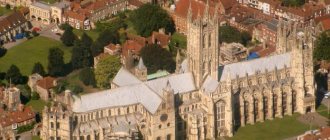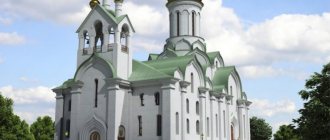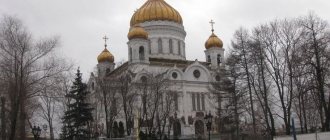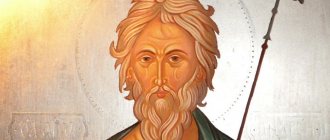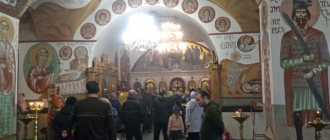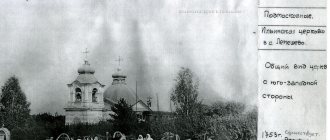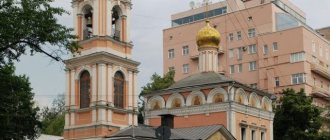From the very beginning, the Anglican Church in Moscow was not only a place of worship, but also the center of public life. Disputes were held here, an archive of historical manuscripts was collected, and a library operated. During the First World War, parishioners opened a military hospital on Voznesensky Lane and provided free meals. At the top of the tower, in a specially equipped hiding place, anyone could rent a box for storing valuables and papers - alas, in 1917 they were all expropriated. The church was famous for its acoustics and organ, which, unfortunately, was lost after the revolution.
History of the Anglican Community in Moscow
The origin of the Anglican community in the Russian capital is associated with the name of Ivan IV the Terrible. It was during his reign that British traders were allowed to gather together and hold worship services according to their national traditions.
At first, services were held in the old church of the German Settlement, and after the fire of 1812 - in the rented part of the mansion that belonged to A. Golitsyna. The first service took place there in November 1825.
After 3 years, the Anglican community bought a plot with a house in what is now Voznesensky Lane. The house was rebuilt and a chapel was opened there.
In the 1870s, it became clear that it could not accommodate all the parishioners who wanted to attend services. During this period, there was an urgent need for the construction of a temple.
Construction of the church
They decided to build it using donations. When the required amount was collected, the community ordered a church design from the English architect R. N. Freeman. In his homeland he was already quite famous for his works.
Almost all of the architect's projects were made in the then popular Gothic Victorian style . The Anglican Church of St. Andrew, the project of which he sent to Moscow, was no exception.
Many historians argue that Freeman didn't try very hard. This was a standard design according to which many churches were built in England at that time.
Interesting fact! There is not a single confirmation that Freeman came to Moscow. Construction was carried out under the leadership of the capital's architect - B. Freudenberg.
Construction of the church began in 1882 and took only 2 years. Already on September 2, 1884, the first service was held there . At the beginning of 1885, Bishop D. Titcomb visited Moscow and consecrated the cathedral in honor of St. Andrew the Apostle, patron saint of Scotland. This choice was dictated by the fact that the majority of the parish at that time were mainly Scots.
History of the cathedral
The first archbishop of the church, Augustine, was sent by Pope Gregory the Great. Augustine of Canterbury founded the cathedral in 597 and named it after Jesus Christ. At first, the temple consisted only of a nave with a vestibule and chapels extending to the north and south.
The Abbey of Saints Peter and Paul was founded nearby, which was later renamed in honor of Augustine himself. For quite a long time, archbishops were buried on the territory of the abbey.
In the 9th-10th centuries the church became larger (4923 m), at which time a square central tower was built on the western side.
In 1011, a surprise attack on Canterbury by the Danes resulted in severe damage to the temple. At the same time, Archbishop Alfeige was killed, later called the martyr archbishop. At the beginning of the 11th century, the walls of the cathedral were somewhat strengthened, and the western apse was added, where the chapel of the Holy Virgin Mary was located.
In 1067, after the Norman Conquest, a fire completely destroyed Canterbury Cathedral. Its restoration began three years later by the first Norman Archbishop Lanfranc. He rebuilt the cathedral using stone brought from France.
The church had a cruciform shape, the nave contained side chapels and consisted of 9 bays. Two towers were also erected in the western part of the building, transepts with apsidal aisles, a low crossed tower and a short choir.
After Lanfranc, Ernulf was elected rector of the church in 1096, under which the eastern part of the cathedral was replaced by a longer section, almost doubling the length of the cathedral.
The greatest popularity of the temple was brought by Thomas Becket, Lord Chancellor of King Henry II. It was at the insistence of the king that Becket took the place of the head of the Anglican Church, and the king hoped for the subordination of spiritual power to secular interests. But Becket defended the interests of the church and did not take into account his past friendship with Henry II.
This irritated the king very much, and he decided to get rid of the archbishop. It is believed that on the orders of the king in 1170, Thomas Becket was killed right in the cathedral by four English barons.
The king later repented and Thomas Becket was canonized. The place where the relics of the holy archbishop were located, Canterbury Cathedral, became a popular place of pilgrimage. At first, the saint's relics were in the crypt of the cathedral, and in 1220 they were transferred to the Chapel of the Holy Trinity. You can learn a lot about pilgrimages from Geoffrey Chaucer’s work “The Canterbury Tales”.
Donations were brought to Becket's coffin, including large ones from kings of other countries and noble people, which aroused the envy of some English monarchs. Thus, Henry VIII in 1538 decided to confiscate the treasures of the church and condemned the late Thomas Becket for treason, after which he robbed Becket's chapel.
Contributions from noble people and donations made it possible to rebuild the cathedral as needed over several centuries. So, after a fire that occurred in 1174, the building was restored with some changes according to the design of the architect Guillaume of Sens; later William of England worked on the project.
The central nave was built between 1378 and 1410 with the participation of Henry Yevel, who also participated in the construction of the church of Westminster Abbey.
The construction of the South Tower was completed in 1460, and the North Tower in 1832. It is the long construction of the cathedral that makes it possible to combine in the architecture of the building all stages of the development of Gothic architecture in England.
Church in the 20th century
The 20th century turned out to be quite eventful for the Anglican Church of St. Andrew.
During the 1917 revolution, the Bolsheviks occupied the church tower and installed machine guns there, pointing them at the White Guards. They also confiscated most of the valuables stored in a specially designated safe room.
After these events, the church functioned for only a short time. Already in February 1921, it was transferred to accommodate the diplomatic representative of Finland. After this, the premises were even used as a dormitory and warehouse, and in 1960 they were occupied by the Melodiya recording studio. Within the walls of the Anglican Cathedral of St. Andrew in Moscow, many musical works have been recorded. The acoustics there are simply amazing!
Only in 1991 did services begin again in the church. At first, parishioners gathered for them once a month, then weekly.
In 1994, Queen Elizabeth II came to Moscow and personally asked B. Yeltsin to return the building to the Anglican community. After this, the Melodiya studio completely vacated the building.
Gradually, the Anglican Church of St. Andrew turned not only into a religious, but also into a cultural center of attraction for Anglicans.
Orthodoxy and Anglicanism have been drawing closer together for centuries, but they still have enough disagreements
Over their centuries-long history, the Orthodox and Anglican Churches have strived for rapprochement. Laymen and priests of both traditions engaged in frequent dialogue, and disagreements in theological dogma were discussed at the highest levels.
Anglicans have shown great tolerance towards Orthodox views, and therefore the media sometimes speculate about the possible unification of the two traditions.
However, Orthodoxy issues rather harsh ultimatums to the Anglican Church, while the Anglicans prefer the opposite path.
In recent decades, there has been a lot of media coverage of two issues on which the two traditions disagree:
- consecration of women as bishops;
- sanctification of homosexual marriages.
The first already exists in the Anglican Church. The second issue is being actively considered by her. This has become a stumbling block in interfaith dialogue.
Information about what the Anglican Church is can be found by watching the video
By leaving a comment, you accept the user agreement
St Andrew's Anglican Church outside and inside
The church building is a typical example of Victorian neo-Gothic with elongated lancet windows and laconic forms. The architectural ensemble also includes the house of the chaplain (priest), built on the church site.
Church architecture
This is a rectangular building with a high square tower on the side. In the upper part it is crowned with four pointed turrets with weather vanes. At the bottom there are two entrances - the main one and the spare one. The main entrance is decorated with small figures of the archangels Michael and Gabriel .
The tower has several floors, which are occupied by office space and a library.
Interesting fact! The church tower does not serve as a bell tower. In fact, bells were never installed on it.
On the eastern side of the building there is an architectural projection with three windows - the apse. This is where the church altar is located.
Interior decoration
Entering the Anglican Church of St. Andrew, you find yourself in a small vestibule, and then in the narthex - the entrance room.
Next is the prayer hall, most of which is occupied by chairs for parishioners. They are positioned so that people sit facing the altar.
Note! The narthex is an extension to the church entrance, where those who were not allowed to attend services in the prayer hall used to pray.
The interior decoration of the church is quite modest. The white walls are decorated with bas-reliefs representing all the steps on the path of Jesus Christ, and rather modern images on the theme of biblical scenes. Under the ceiling there is a system of oak rafters, creating an amazing medieval atmosphere.
Current state of the temple
Canterbury Cathedral is a very complex composition: there are a large number of successive buildings and rooms that surround numerous extensions, all of which belong to different stages of construction.
A huge tetrahedral tower rises above all these buildings. There are also two towers located on the west side of the cathedral. That is why Canterbury Cathedral does not make a solid impression when viewed from the outside.
The nave is framed on both sides by colonnades, and the columns on top are decorated with medieval “wickerwork” ornament. The lancet windows of the side naves are considered one of the tallest in England. The cathedral's choir dates back to early English Gothic, and is joined by chapels containing works of art and various relics.
One of these relics is the “Chair of St. Augustine,” where the archbishop’s consecration ceremony takes place. Another relic is considered to be the "Crown of Becket", which was thrown from his head during the murder.
St. Augustine's chair
One of the impressive works of art in the cathedral is the painting "Apostle Paul with a Snake", which belongs to English monumental painting with notable Byzantine traditions.
The cathedral amazes with its stained glass windows of the 12th-13th centuries, especially the stained glass windows with biblical scenes, which are located in the western window. Many of these stained glass windows were destroyed during World War II and later restored.
The cathedral is the burial place of archbishops and prominent figures. For example, Edward Woodstock, nicknamed the Black Prince, who is famous for his victories in significant battles of the Hundred Years War, is buried here.
Edward Woodstock, nicknamed the Black Prince
Thanks to donations, the cathedral collection contains many books (more than 50 thousand copies), including those published before the 20th century. These are books on British history, theology, church history, science, medicine, travel, etc.
Near the cathedral you can see the monastery garden, two cloisters (or courtyards) and numerous auxiliary buildings that were built at different times.
Cathedral backyard
Recently, experts inspecting Canterbury Cathedral have found some damage in the building that could lead to serious consequences if not repaired in time. Thus, cracks appear in the masonry of the cathedral, stained glass windows rust, and the roof is partially destroyed. In 2006, a fundraising campaign was launched in England to restore the cathedral.
Visiting the Anglican Church in Moscow
In the Anglican Cathedral of St. Andrew in Moscow, not only divine services are held. He is also known for his concerts - on wind instruments, digital organ. Rock operas, ethnic, classical, and jazz works are played here. Ticket prices start from 800 rubles.
The church also has an Orthodox center, a Sunday school, and a theological library. St. Andrew's Church is an island of good old England in the Russian capital. It will be interesting to visit for both children and adults.
